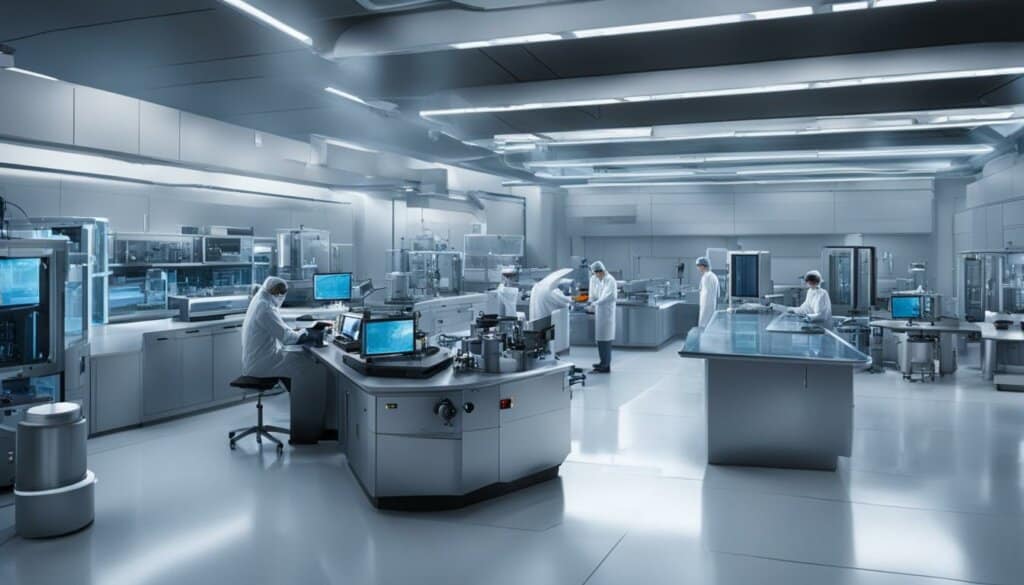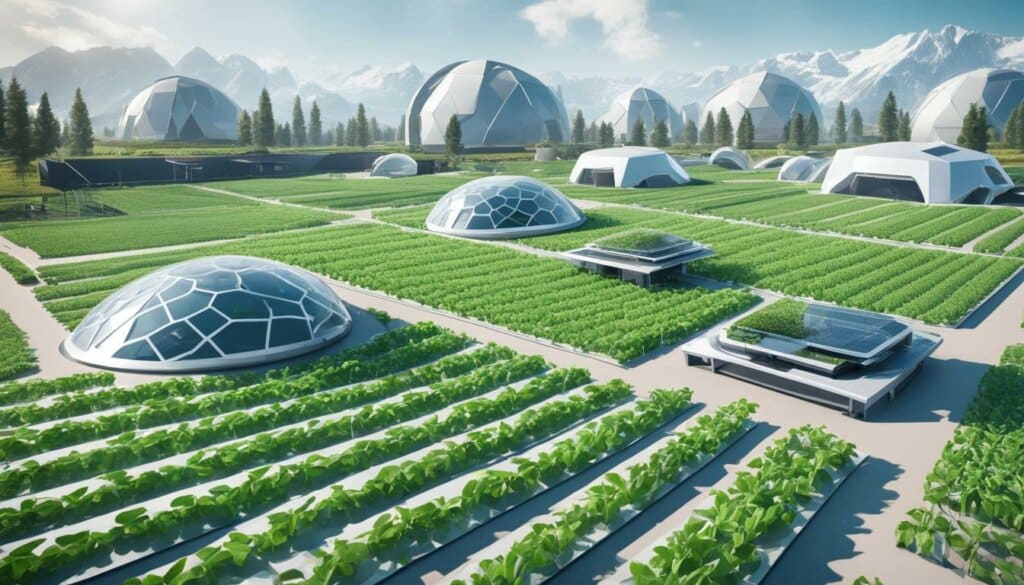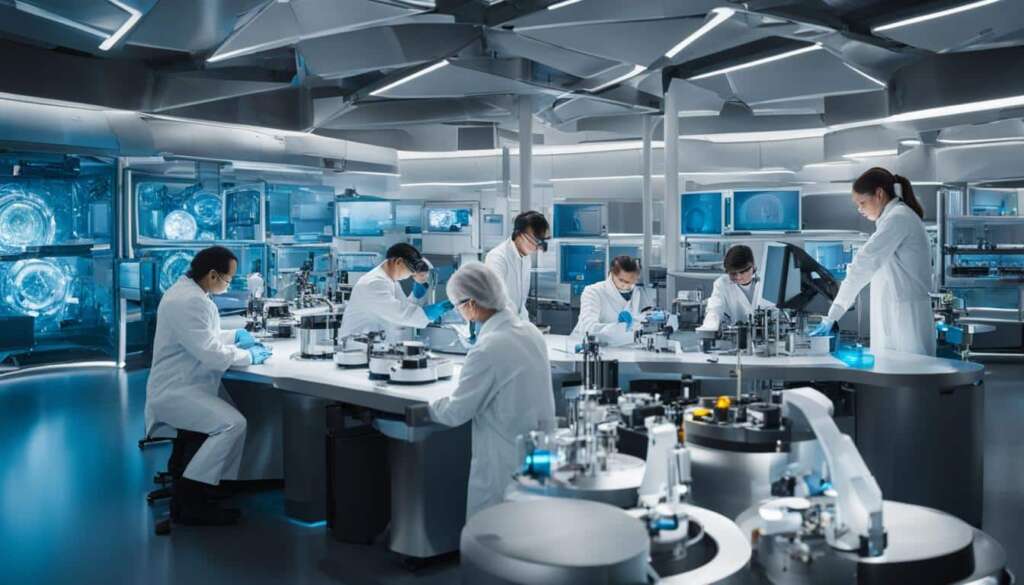Table of Contents
Atomic-scale innovations in material sciences and microscopy are driving the future of nanotechnology, with transformative potential across industries. Nanomaterials, engineered by startups, are enabling the creation of new structures and composite materials. Additionally, nanotechnology is facilitating advancements in additive manufacturing, quantum computing, and precision biotechnology.
Key Takeaways:
- The future of nanotechnology holds transformative potential for various industries.
- Nanomaterials are being used by startups to engineer new structures and composite materials.
- Nanotechnology enables advancements in additive manufacturing, quantum computing, and precision biotechnology.
Top Nanotechnology Trends in 2024
The field of nanotechnology is rapidly evolving, with new advancements and trends emerging every year. In 2024, several top nanotechnology trends are expected to shape the industry and revolutionize various sectors. Let’s explore some of these exciting trends:
- Advanced Carbon Nanomaterials: Carbon nanomaterials, such as graphene and carbon nanotubes, are revolutionizing industries with their exceptional properties. These materials offer high strength, conductivity, and flexibility, making them ideal for applications in electronics, energy storage, and advanced materials.
- Semiconductor Nanodevices: Nanotechnology is driving the development of miniaturized semiconductor devices and nanorobotics. These devices have the potential to revolutionize high-performance computing, electronic sensing, and industrial applications like remote monitoring and servicing in hazardous environments.
- Green Nanotechnology: With a focus on sustainability, nanotechnology is paving the way for greener synthesis methods and practices. Biofabrication techniques are enabling the development of biomaterials from renewable sources, while circular economy measures encourage the use of biodegradable nanomaterials created from recycled waste.
- Nanocomposites: Nanocomposites, such as metal-organic framework crystals and carbon fiber reinforced polymers, are revolutionizing industries like automotive and aerospace. These materials offer enhanced strength, durability, and unique properties, making them highly sought after for various applications.
- Nanosensors: Nanotechnology-enabled sensors are becoming increasingly prevalent in diverse sectors, including healthcare, environment monitoring, and manufacturing. These sensors offer high sensitivity, selectivity, and real-time monitoring capabilities, enabling advanced data collection and analysis.
- Nanofilms: Nanotechnology is driving the development of thin films with unique properties and functionalities. These nanofilms find applications in areas such as electronics, energy storage, and optical coatings, revolutionizing industries and enabling new technological advancements.
- Nanoencapsulation: Nanoencapsulation is a technique that involves the encapsulation of active substances or particles within nanosized capsules. This approach offers numerous advantages, including controlled release of drugs, enhanced stability, and improved bioavailability. Nanoencapsulation is being explored in various fields, including pharmaceuticals, food science, and agriculture.
- Energy Nanomaterials: Nanotechnology is playing a crucial role in the development of advanced energy materials. Nanomaterials are being used to enhance the performance and efficiency of energy storage systems, solar cells, and fuel cells, contributing to the sustainable energy transition.
- Computational Nanotechnology: Computational methods and simulations are aiding nanotechnology research and development. These techniques allow scientists to model and predict the behavior of nanoscale systems, facilitating the design and optimization of nanomaterials, devices, and processes.
Carbon Nanomaterials
Startups are continuously developing new methods to synthesize carbon nanomaterials, such as graphene, carbon dots, and carbon nanotubes (CNTs). These carbon nanomaterials have superior mechanical strength, chemical stability, durability, and flexibility compared to conventional materials.
They find applications in electronics, tissue engineering, and textiles, and are also used as nanofillers in electronic structures.
Advantages of Carbon Nanomaterials
Carbon nanomaterials possess remarkable properties that make them highly coveted in various industries:
- Superior mechanical strength: Carbon nanomaterials exhibit exceptional strength, allowing for the construction of lightweight yet sturdy structures.
- Chemical stability: These materials are resistant to chemical degradation, making them suitable for use in harsh environments.
- Durability: Carbon nanomaterials have a long lifespan, ensuring the longevity of products and materials.
- Flexibility: The inherent flexibility of carbon nanomaterials allows for their application in various forms, such as films and coatings.
These advantages drive their utilization in cutting-edge industries, revolutionizing technology and manufacturing processes. Let’s delve deeper into a few key application areas:
Electronics
Carbon nanotubes, specifically, have revolutionized the field of electronics. Their unique atomic structure and conductivity make them excellent candidates for components such as transistors, conductive films, and displays.
Tissue Engineering
Carbon nanomaterials have paved the way for advancements in tissue engineering. They can be used as scaffolds to support cell growth and regeneration, enabling the development of artificial tissues and organs.
Textiles
Incorporating carbon nanomaterials into textiles enhances their properties, resulting in fabrics with improved strength, durability, and functionality. These advanced textiles find applications in sports gear, protective clothing, and smart textiles.
As carbon nanomaterials continue to evolve and become more accessible, their impact across industries is expected to escalate, fueling innovation and driving technological breakthroughs.
Semiconductor Nanodevices
Advances in miniaturization have led to the development of nanoscale semiconductor devices and nanorobotics. Startups utilize molecular nanotechnology (MNT) to manufacture devices and scientific instruments with high precision, such as nanomanipulators and nanotransistors. These nanodevices have applications in high-performance computing, electronic sensing, and industrial use cases like remote monitoring and servicing in hazardous environments.
With the increasing demand for smaller and more efficient electronic devices, semiconductor nanodevices have become crucial components in various industries. These devices are revolutionizing the field of electronics by enabling enhanced performance and functionality at the nanoscale.
Nanobots: The Future of Molecular Nanotechnology
Nanobots, small robots designed at the nanoscale, are a remarkable achievement in molecular nanotechnology. They have the potential to perform complex tasks with precision and efficiency, opening new possibilities in healthcare, manufacturing, and environmental monitoring.
Imagine nanobots specifically programmed to target cancer cells and deliver drugs with pinpoint accuracy, eliminating the need for invasive surgeries or harsh chemotherapy. This combination of semiconductor nanodevices and nanobots has the potential to revolutionize the medical field and save countless lives.
In addition to healthcare applications, nanobots can be used in industrial settings to carry out tasks that are dangerous or impossible for humans. From inspecting and maintaining equipment in hazardous environments to assembling complex structures at the molecular level, nanobots offer unprecedented versatility and precision.
Applications of Semiconductor Nanodevices:
Semiconductor nanodevices find applications across various fields, contributing to advancements and innovations. Here are some notable applications:
- High-performance computing: Nanodevices enable faster and more efficient computing processes, allowing for complex calculations and data analysis.
- Electronic sensing: Semiconductor nanosensors provide highly sensitive and accurate detection of various substances and environmental conditions.
- Industrial use cases: Nanodevices play a crucial role in remote monitoring and servicing in hazardous environments, increasing safety and efficiency.
The combination of semiconductor nanodevices, nanobots, and molecular nanotechnology has the potential to reshape industries and drive significant advancements in the future.
![]()
Molecular Nanotechnology: Shaping the Future
Molecular nanotechnology holds immense potential in revolutionizing various industries. Its ability to manipulate matter at the molecular level opens up possibilities for creating advanced materials, precise manufacturing processes, and innovative scientific instruments.
As the field of molecular nanotechnology continues to evolve, we can expect breakthroughs in quantum computing, DNA sequencing, and nanomedicine, among other fields.
With ongoing research and development, semiconductor nanodevices and molecular nanotechnology will continue to drive transformative changes, shaping the future of technology and industries.
| Advantages of Semiconductor Nanodevices | Applications of Semiconductor Nanodevices |
|---|---|
| – Miniaturization | – High-performance computing |
| – Precision manufacturing | – Electronic sensing |
| – Enhanced functionality | – Industrial use cases |
| – Increased efficiency |
Green Nanotechnology
The nanotechnology sector is undergoing a significant transition towards greener synthesis methods and practices. Startups are harnessing the power of biofabrication to develop biomaterials using sustainable and biobased raw materials. Additionally, circular economy measures are facilitating the development of biodegradable polymeric and metal nanomaterials from recycled waste. This shift towards green nanotechnology not only contributes to environmental sustainability but also opens up new avenues for innovation and economic growth.
One of the key drivers of green nanotechnology is biofabrication. This innovative approach utilizes biological systems and processes to construct nanoscale structures and materials. By leveraging the principles of biology, biofabrication enables the development of biomaterials that are both eco-friendly and highly functional. These biomaterials find applications in various industries, including healthcare, electronics, and energy.
The circular economy is another crucial aspect of green nanotechnology. It aims to minimize waste generation and maximize resource efficiency by promoting the reuse, recycling, and regeneration of materials. In the context of nanotechnology, circular economy measures enable the transformation of waste materials into valuable nanomaterials through appropriate recycling and upcycling processes. This not only reduces the environmental impact of nanotechnology but also contributes to the creation of a sustainable and circular economy.
The Key Benefits of Green Nanotechnology:
- Reduces dependence on non-renewable resources
- Minimizes environmental impact
- Promotes sustainable development
- Enhances product performance and functionality
- Improves resource efficiency
Green nanotechnology has a wide range of applications across various sectors. One of the notable applications is in the field of environmental remediation. Nanotechnology enables the development of innovative solutions for bioremediation, which involves the use of nanomaterials to clean up contaminated soil, wastewater, and oil spills. These nanomaterials can efficiently remove pollutants and transform them into less harmful substances, offering a sustainable approach to environmental remediation.
The image above illustrates the concept of green nanotechnology and its potential to contribute to a sustainable future. By embracing biofabrication, circular economy principles, and innovative applications, green nanotechnology has the power to transform industries and pave the way for a more sustainable and environmentally friendly future.
Nanocomposites
Nanocomposites play a crucial role in various industries, including automotive and aerospace. These innovative materials, such as metal-organic framework (MOF) crystals, carbon fiber reinforced polymers (CFRP), and nano-ceramics, offer exceptional properties that set them apart. Their high surface-to-volume ratio and unique microscopic characteristics contribute to their superior performance and versatility.
In the automotive industry, nanocomposites are utilized as coatings, additives, catalysts, and structural components to enhance the overall performance of vehicles. They improve strength, durability, and fuel efficiency, while also reducing weight and environmental impact. Nanocomposites have the potential to revolutionize aerospace as well, where their lightweight yet robust nature can optimize aircraft design, improve fuel efficiency, and ensure safety.
Biotechnology is another field benefiting from nanocomposites. They are employed in the development of advanced drug delivery systems, biomaterials, and tissue engineering scaffolds. The incorporation of nanocomposites in medical devices and implants enhances their durability and biocompatibility, leading to improved patient outcomes.
One notable nanocomposite is the metal-organic framework (MOF) crystal. These crystalline structures have a large porosity and surface area, making them ideal for applications such as gas storage and separations, drug delivery, and catalysis. MOFs have shown great potential in addressing pressing environmental issues and advancing sustainable development.
To provide a comprehensive overview of the applications and benefits of nanocomposites, the following table highlights key industries and their utilization of nanocomposites:
| Industry | Nanocomposite Applications |
|---|---|
| Automotive | Coatings, additives, catalytic converters, lightweight components |
| Aerospace | Structural materials, fuel efficiency enhancement |
| Biotechnology | Drug delivery systems, tissue engineering scaffolds |
Nanocomposites are undoubtedly transforming industries and driving innovation in numerous fields. Their unique properties and wide-ranging applications offer unparalleled opportunities for development and advancement. As startups continue to explore and harness the potential of nanocomposites, we can expect further breakthroughs that shape the future of various industries.

Nanomedicine
Nanotechnology has revolutionized the field of medicine, opening up new possibilities for drug delivery, imaging, and tissue engineering. With its transformative potential, nanomedicine is making significant contributions to improving patient care and treatment outcomes.
One of the key areas where nanotechnology is making a difference is in drug delivery. By utilizing nanoparticles, drugs can be transported directly to the target site in the body, bypassing healthy tissues and reducing side effects. This targeted drug delivery system enhances the efficacy of medications, ensuring that they reach their intended destination with precision.
Nanoparticles are designed to carry therapeutic agents, such as chemotherapy drugs, antibodies, or gene therapies, to specific cells or tissues. These microscopic carriers can be functionalized with ligands or antigens that selectively bind to cell receptors, enabling targeted treatment. This approach not only enhances the effectiveness of the drug but also minimizes damage to healthy cells, leading to improved patient outcomes.
Nanobots, another fascinating innovation in nanomedicine, are being explored for a wide range of medical purposes. These tiny robots, often measuring less than one-thousandth the width of a human hair, have the potential to revolutionize healthcare through precise diagnostics and drug delivery. By employing nanobots, doctors can introduce therapeutic agents directly to the affected area, providing highly localized treatments.
Moreover, nanobots can navigate through the bloodstream to detect early signs of diseases, monitor vital parameters, or deliver targeted therapies to specific organs or tissues. These intelligent nano-agents can be programmed to respond to specific signals, making them capable of autonomous action within the body. This has the potential to revolutionize diagnostics, treatment, and patient care.
Nanoparticles for Tissue Engineering
Bioprinting, a cutting-edge technique in nanomedicine, utilizes nanoparticles to create three-dimensional structures of living tissues and organs. By combining biologically compatible materials and stem cells, scientists are able to recreate complex anatomical structures with remarkable precision.
Bioprinting with nanoparticles offers tremendous potential in regenerative medicine and transplantation. It allows researchers to fabricate functional tissues and organs tailored to a patient’s unique needs, reducing the risk of rejection and improving treatment outcomes.
Through nanotechnology, it is now possible to print functional blood vessels, heart tissues, and even entire organs. This breakthrough has the potential to transform healthcare by addressing the global shortage of organ donors and revolutionizing the field of transplantation.
Nanomedicine holds great promise for the future of healthcare. As technology continues to advance, nanotechnology will continue to play a critical role in improving drug delivery systems, diagnostics, and tissue engineering. The transformative impact of nanomedicine is set to revolutionize patient care, offering new hope and possibilities for the future.
Nanotechnology in Construction
Nanotechnology is revolutionizing the construction industry, introducing innovative materials and techniques that enhance the strength, durability, and adaptability of structures. Through nano-scale engineering, stronger, self-healing, and self-assembling materials can be developed, transforming the way we build.
One of the key applications of nanotechnology in construction is the creation of materials at the molecular scale. By manipulating matter at this level, it is possible to design materials with enhanced properties, such as increased strength, improved resistance to wear and tear, and higher tolerance to extreme conditions. These advanced materials can withstand greater loads and provide greater longevity to structures.
Additionally, 3D printing with nanomaterials is reshaping the construction industry, enabling the creation of customized structures with unprecedented precision and efficiency. With 3D printing, architects and engineers can fabricate complex designs using a range of pliable materials, including plastics, ceramics, metals, and graphene. This technology allows for faster construction processes, reduced material waste, and enhanced architectural freedom.
Moreover, nanotechnology offers the possibility of self-assembling materials, wherein the individual components come together autonomously to form a larger structure. This self-assembly capability simplifies construction processes and reduces the need for manual labor, ultimately leading to cost savings and increased efficiency.
To illustrate the transformative power of nanotechnology in construction, let’s take a closer look at some key advancements:
1. Nano-Enhanced Concrete
Scientists and engineers are incorporating nanomaterials, such as carbon nanotubes or nanoparticles, into concrete to enhance its strength and durability. These additives fill in the gaps between traditional concrete particles, making the material more compact and resistant to cracks and deterioration. Nano-enhanced concrete has the potential to revolutionize the construction industry by increasing the lifespan of structures and reducing the need for repairs and replacements.
2. Self-Healing Materials
Nanotechnology enables the development of self-healing materials that can repair themselves when damaged. Microcapsules filled with a healing agent are embedded in the material, and when cracks or fractures occur, these capsules rupture and release the healing agent, which fills the gaps and restores the material’s integrity. Self-healing materials have the potential to significantly extend the lifespan of buildings and infrastructure, minimizing maintenance costs and increasing safety.
3. Smart Windows
Nanotechnology is also advancing the development of smart windows, which can dynamically control heat, light, and privacy. By embedding nanoparticles into the glass, these windows can change their properties in response to external factors such as sunlight or electrical signals. Smart windows improve energy efficiency by regulating heat transfer, reduce glare, and enhance occupant comfort.
| Advantages of Nanotechnology in Construction | Applications |
|---|---|
| Enhanced strength and durability | Concrete additives, coatings, structural materials |
| Self-healing and self-assembling properties | Concrete, coatings, structural materials |
| Improved energy efficiency | Smart windows, insulation materials |
| Customized and complex structures | 3D printing, architectural components |
By harnessing the power of nanotechnology, the construction industry can unlock unprecedented possibilities in designing, constructing, and maintaining intelligent and sustainable buildings. As research and development in this field continue to progress, nanotechnology is set to reshape the way we build, creating structures that are stronger, smarter, and more resilient than ever before.
Next, let’s explore the impact of nanotechnology in the realm of food and agriculture.
Nanotechnology in Food and Agriculture
Nanotechnology is revolutionizing the food and agriculture sectors, offering numerous benefits such as improved food safety, enhanced quality, and sustainable practices. By harnessing the power of nanotechnology, researchers and innovators are finding innovative solutions to address challenges and ensure the future of our food production.
One key application of nanotechnology in the food industry is the use of nanoparticles in packaging. These nanomaterials help to prolong the shelf life of perishable food items by creating a barrier that prevents moisture, gases, and microbes from entering the packaging. As a result, it enhances food safety and quality, reducing food waste and the need for chemical preservatives.
In addition to packaging, nanotech-based sensors and diagnostics play a crucial role in assuring the quality of food products. These sensors can detect contaminants, pathogens, and spoilage markers at ultra-low levels, enabling early detection and prevention of foodborne illnesses. This technology not only enhances food safety but also improves the overall efficiency of the food supply chain.
In the field of agriculture, nanomaterials are utilized for various purposes, including crop protection, nutrient delivery, and soil remediation. Nanoparticles can act as carriers for pesticides, delivering them directly to targeted areas of the plant while reducing the environmental impact associated with traditional spraying methods. This precision targeting reduces the amount of pesticide used and minimizes its dispersal into the environment.
Furthermore, nanotechnology enables controlled and targeted nutrient delivery to plants, ensuring optimal growth and productivity. Nanoscale fertilizers and soil amendments are designed to release nutrients gradually, reducing nutrient loss and pollution caused by excess fertilizer application. This technology promotes sustainable agriculture by improving crop efficiency and reducing the environmental impact of agriculture practices.
The exploration of bioprocessing and bioprinting techniques in nanotechnology opens up possibilities for personalized nutrition and tissue engineering in the agricultural sector. Researchers are developing methods to produce bioengineered food using nanoscale structures, enabling customization of nutritional content and meeting the specific dietary needs of individuals. This technology has the potential to revolutionize personalized nutrition, addressing individual health needs and combating malnutrition.

The Benefits of Nanotechnology in Food and Agriculture:
- Improved food safety and quality
- Reduced food waste and chemical preservatives
- Enhanced crop protection and reduced environmental impact
- Precision nutrient delivery for optimized plant growth
- Sustainable agriculture practices
- Potential for personalized nutrition and bioengineered food
The integration of nanotechnology in the food and agriculture sectors heralds a new era of innovation and sustainability. By leveraging nanomaterials, sensors, and advanced techniques, we can enhance food safety, improve agricultural practices, and ensure a more sustainable future for our planet.
Nanotechnology in Health and Wellness
Nanotechnology has revolutionized the healthcare industry, bringing forth advancements in enhanced diagnostics, targeted drug delivery, and personalized medicine. The application of nanotechnology in health and wellness has paved the way for significant breakthroughs that are reshaping the medical landscape.
One of the key contributions of nanotechnology in healthcare is the utilization of nanoparticles in imaging techniques. These tiny particles enhance resolution and contrast in medical imaging, enabling healthcare professionals to obtain more accurate and detailed information about diseases and conditions. Whether it’s detecting tumors or identifying cellular abnormalities, enhanced diagnostics powered by nanotechnology are enabling early and accurate diagnoses.
“The use of nanomedicine has revolutionized drug delivery, allowing for precise targeting of medications to specific cells or tissues, resulting in improved therapeutic outcomes.”
Another significant application of nanotechnology in health and wellness is nanomedicine. This field focuses on developing nanoscale devices and systems for medical purposes. Nanoparticles are designed to encapsulate and transport drugs to their intended targets in the body, enabling precise drug delivery. By selectively targeting diseased cells while sparing healthy ones, nanomedicine reduces the side effects associated with conventional drug delivery methods. This targeted approach not only improves patient comfort but also enhances the efficacy of treatments.
In addition to diagnostics and drug delivery, nanotechnology is driving the development of nanosensors and wearable devices for real-time health monitoring and disease management. These devices are designed to monitor vital signs, track health parameters, and detect early signs of potential health issues. With the ability to continuously collect and analyze data, nanosensors and wearables provide valuable insights into an individual’s health status, enabling timely interventions and personalized medicine.
Overall, nanotechnology is playing a crucial role in advancing healthcare by improving diagnostics, enabling targeted drug delivery, and empowering individuals with real-time health monitoring. As research and innovation in nanotechnology continue to progress, the potential for further transformative advancements in health and wellness is immense.
| Benefits of Nanotechnology in Health and Wellness | Applications |
|---|---|
| Enhanced diagnostics | Imaging techniques with improved resolution and contrast |
| Precise drug delivery | Nanoparticles for targeted drug delivery, reducing side effects |
| Real-time health monitoring | Nanosensors and wearable devices for continuous health monitoring |
| Personalized medicine | Nanotechnology-enabled diagnostics and treatments tailored to individual needs |
Conclusion
The field of nanotechnology is poised to have a profound impact on industries, paving the way for transformative advancements and shaping the future. With emerging trends like advanced carbon nanomaterials, nanocomposites, and nanomedicine, nanotechnology is revolutionizing various sectors with its boundless potential.
The development of advanced carbon nanomaterials, including graphene and carbon nanotubes, is driving innovations in electronics, tissue engineering, and textiles. Nanocomposites, such as metal-organic frameworks and carbon fiber reinforced polymers, are finding applications in automotive and aerospace industries, offering superior properties and enhanced performance.
Nanomedicine, in the form of drug delivery systems and bioprinting, is transforming healthcare by enabling precise diagnostics, effective therapies, and personalized medicine. As research and innovation in nanotechnology continue to flourish, the future holds immense promise for further breakthroughs, fueling progress in economies, healthcare, and sustainability.
FAQ
What is the future of nanotechnology?
The future of nanotechnology holds immense transformative potential across various industries. It is driving advancements in material sciences, microscopy, and additive manufacturing, fostering innovations in fields like quantum computing, precision biotechnology, and more.
What are the top nanotechnology trends in 2024?
The top nanotechnology trends in 2024 include advanced carbon nanomaterials, semiconductor nanodevices, green nanotechnology, nanocomposites, nanosensors, nanofilms, nanoencapsulation, energy nanomaterials, and computational nanotechnology. These trends are expected to shape the future of nanotechnology and have significant impacts in industries.
What is the significance of carbon nanomaterials in nanotechnology?
Carbon nanomaterials, such as graphene, carbon dots, and carbon nanotubes (CNTs), have superior mechanical strength, chemical stability, durability, and flexibility compared to conventional materials. They are used in various applications ranging from electronics to tissue engineering and as nanofillers in electronic structures.
How are semiconductor nanodevices revolutionizing industries?
Semiconductor nanodevices, manufactured using molecular nanotechnology (MNT), have high precision and find applications in high-performance computing, electronic sensing, and industrial use cases such as remote monitoring and servicing in hazardous environments. Nanobots are being explored for medical purposes like precise drug delivery and diagnostics.
What is green nanotechnology?
Green nanotechnology refers to the transition towards greener synthesis methods and practices in the field of nanotechnology. Startups are leveraging biofabrication techniques and circular economy measures to develop biomaterials from sustainable and biobased raw materials. Nanotechnology enables environment-friendly use cases such as bioremediation and biotransformation of pollutants in soil, wastewater, and oil spills.
How are nanocomposites being used in industries?
Nanocomposites, such as metal-organic framework (MOF) crystals, carbon fiber reinforced polymers (CFRP), and nano-ceramics, have superior properties due to their high surface-to-volume ratio and unique microscopic characteristics. They are used as coatings, additives, catalysts, and structural components in industries including automotive, aerospace, and biotechnology.
What is the role of nanomedicine in healthcare?
Nanomedicine has revolutionized the healthcare industry by enabling enhanced diagnostics, targeted drug delivery, and personalized medicine. Nanoparticles are used in imaging techniques for improved resolution and contrast. Nanomedicine enables precise drug targeting, reducing side effects and improving therapeutic outcomes. Nanosensors and wearable devices are being developed for real-time health monitoring and disease management.
How is nanotechnology revolutionizing the construction industry?
Nanotechnology is revolutionizing the construction industry by enabling the development of stronger, self-healing, and self-assembling materials. Through nano-scale engineering, materials at the molecular scale can be designed for enhanced strength, durability, and adaptability. 3D printing with nanomaterials is also being used to create customized structures with advanced pliable materials such as plastics, ceramics, metals, and graphene.
How is nanotechnology being utilized in the food and agriculture sectors?
Nanotechnology is being harnessed in the food and agriculture sectors for improved food safety, quality, and sustainable practices. Nanoparticles are used in packaging to prolong shelf life and enhance barrier properties. Nanotech-based sensors and diagnostics enhance food quality assurance. In agriculture, nanomaterials are used for crop protection, nutrient delivery, and soil remediation. Bioprocessing and bioprinting techniques are being explored for personalized nutrition and tissue engineering.
What are the applications of nanotechnology in health and wellness?
Nanotechnology has revolutionized the healthcare industry by enabling enhanced diagnostics, targeted drug delivery, and personalized medicine. Nanoparticles are used in imaging techniques for improved resolution and contrast. Nanomedicine enables precise drug targeting, reducing side effects and improving therapeutic outcomes. Nanosensors and wearable devices are being developed for real-time health monitoring and disease management.







